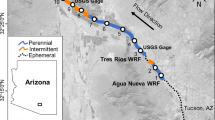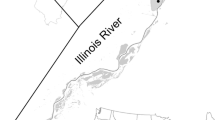Abstract
The competing demands of the environment and agriculture has challenged managers of waterways and prompted the development of new and novel ways of providing water for consumptive use without compromising the aquatic ecosystem. One partial remedy that has been proposed involves using wetlands as intermediary off-river storages to achieve consumptive benefits whilst maintaining ecological values. This study assessed the suitability of such a strategy by examining the impact of artificial drawdown on wetland zooplankton communities. An experiment was undertaken in outdoor mesocosms in which two treatments were compared over a 109-day duration: (1) partial artificial drawdown—where approximately half of the water was siphoned out after 42 days; and (2) natural drawdown—where the water was left to drawdown naturally via evaporation. Artificial drawdown only caused a small acceleration (<4 weeks) in the decline of abundance and density associated with natural population fluctuations, and temporarily changed the community structure. Furthermore, it had no effect on taxon richness, community composition and the initiation of dormancy. This suggests that wetlands could potentially be used for supporting consumptive demands whilst still maintaining abundant and diverse zooplankton communities, and hence a suitable food supply for higher order consumers such as fish and waterfowl.





Similar content being viewed by others
References
Arthington, A. H., R. J. Naiman, M. E. McClain & C. Nilsson, 2010. Preserving the biodiversity and ecological services of rivers: new challenges and research opportunities. Freshwater Biology 55: 1–16.
Baldwin, D. S. & A. M. Mitchell, 2000. The effects of drying and re-flooding on the sediment and soil nutrient dynamics of lowland river-floodplain systems: a synthesis. Regulated Rivers: Research and Management 16: 457–467.
Baranyi, C., T. Hein, C. Holarek, S. Keckeis & F. Schiemer, 2002. Zooplankton biomass and community structure in a Danube River floodplain system: effects of hydrology. Freshwater Biology 47: 473–482.
Baron, J. S., N. L. Poff, P. L. Angermeier, C. N. Dahm, P. H. Gleick, N. G. Hairston, R. B. Jackson, C. A. Johnston, B. D. Richter & A. D. Steinman, 2002. Meeting ecological and societal needs for freshwater. Ecological Applications 12: 1247–1260.
Boltovskoy, D. & H. E. Mazzoni, 1988. The effects of sampling gear and environmental conditions on the abundance estimates of freshwater zooplankton. Revue d’Hydrobiologie Tropicale 21: 21–34.
Boulton, A. J. & L. N. Lloyd, 1992. Flooding frequency and invertebrate emergence from dry floodplain sediments of the River Murray, Australia. Regulated Rivers: Research and Management 7: 137–151.
Bunn, S. E., P. M. Davies & M. Winning, 2003. Sources of organic carbon supporting the food web of an arid zone floodplain river. Freshwater Biology 48: 619–635.
Casanova, M. T. & M. A. Brock, 2000. How do depth, duration and frequency of flooding influence the establishment of wetland plant communities? Plant Ecology 147: 237–250.
Clarke, K. R. & R. M. Warwick, 2001. Change in marine communities: an approach to statistical analysis and interpretation. PRIMER-E, Plymouth.
Cole, J. J., S. R. Carpenter, J. F. Kitchell & M. L. Pace, 2002. Pathways of organic carbon utilization in small lakes: results from a whole-lake 13C addition and coupled model. Limnology and Oceanography 47: 1664–1675.
Fraser, L. H. & P. Keddy, 1997. The role of experimental microcosms in ecological research. Trends in Ecology & Evolution 12: 478–481.
Gawne, B., L. Crase & A. S. Watson, 2010. Can a collaborative focus on solutions improve our capacity to achieve sustainable water management? Marine and Freshwater Research 61: 814–820.
Gilbert, J. J., 1974. Dormancy in rotifers. Transactions of the American Microscopical Society 93: 490–513.
Gilbert, J. J. & T. Schröder, 2004. Rotifers from diapausing, fertilized eggs: unique features and emergence. Limnology and Oceanography 49: 1341–1354.
Growns, J. E. & I. O. Growns, 1996. Predicting species richness for Australasian freshwater macroinvertebrates: do we want to know? Memoirs of the Museum of Victoria 56: 223–230.
Gyllström, M. & L. A. Hansson, 2004. Dormancy in freshwater zooplankton: induction, termination and the importance of benthic-pelagic coupling. Aquatic Sciences 66: 274–295.
Hillman, T. J., 1986. Billabongs. In De Deckker, P. & W. D. Williams (eds), Limnology in Australia. CSIRO Australia/Dr W. Junk Publishers, Melbourne: 457–470.
Hladyz, S., S. C. Watkins, K. L. Whitworth & D. S. Baldwin, 2011. Flows and hypoxic blackwater events in managed ephemeral river channels. Journal of Hydrology 401: 117–125.
ISO, 1992. Water quality – measurement of biochemical parameters – spectrometric determination of the chlorophyll-a concentration. ISO 10260, International Organization for Standardization.
James, C. S., M. C. Thoms & G. P. Quinn, 2008. Zooplankton dynamics from inundation to drying in a complex ephemeral floodplain-wetland. Aquatic Sciences 70: 259–271.
Johannsson, O. E., M. A. Shaw, N. D. Yan, J.-M. Filion & D. F. Malley, 1993. A comparison of freshwater zooplankton sampling gear: nets, traps and submersible pump. Canadian Technical Report of Fisheries and Aquatic Sciences 1894: 1–29.
Jolly, I. D., K. L. McEwan & K. L. Holland, 2008. A review of groundwater-surface water interactions in arid/semi-arid wetlands and the consequences of salinity for wetland ecology. Ecohydrology 1: 43–58.
Kobayashi, T., P. Gibbs, P. I. Dixon & R. J. Shiel, 1996. Grazing by a river zooplankton community: importance of microzooplankton. Marine and Freshwater Research 47: 1025–1036.
McCullough, C. D. & P. Horwitz, 2010. Vulnerability of organic acid tolerant wetland biota to the effects of inorganic acidification. Science of the Total Environment 408: 1868–1877.
Neckles, H. A., H. R. Murkin & J. A. Cooper, 1990. Influences of seasonal flooding on macroinvertebrate abundance in wetland habitats. Freshwater Biology 23: 311–322.
Nielsen, D. L., R. J. Shiel & F. J. Smith, 1998. Ecology versus taxonomy: is there a middle ground? Hydrobiologia 387(388): 451–457.
Nielsen, D. L., T. J. Hillman, F. J. Smith & R. J. Shiel, 2002. The influence of seasonality and duration of flooding on zooplankton in experimental billabongs. River Research and Applications 18: 227–237.
Nielsen, D. L., H. Gigney & G. Watson, 2010. Riverine habitat heterogeneity: the role of slackwaters in providing hydrologic buffers for benthic microfauna. Hydrobiologia 638: 181–191.
Obertegger, U., A. Borsato & G. Flaim, 2010. Rotifer–crustacean interactions in a pseudokarstic lake: influence of hydrology. Aquatic Ecology 44: 121–130.
Quinn, G. P. & M. J. Keough, 2002. Experimental design and data analysis for biologists. Cambridge University Press, Cambridge, UK.
Quinn, G. P., T. J. Hillman & R. Cook, 2000. The response of macroinvertebrates to inundation in floodplain wetlands: a possible effect of river regulation? Regulated Rivers: Research and Management 16: 469–477.
Reid, M. A. & J. J. Brooks, 2000. Detecting effects of environmental water allocations in wetlands of the Murray–Darling Basin, Australia. Regulated Rivers: Research and Management 16: 479–496.
Robertson, A. I., P. Bacon & G. Heagney, 2001. The responses of floodplain primary production to flood frequency and timing. Journal of Applied Ecology 38: 126–136.
Rossetti, G., P. Viaroli & I. Ferrari, 2009. Role of abiotic and biotic factors in structuring the metazoan plankton community in a lowland river. River Research and Applications 25: 814–835.
Sheldon, F. & K. F. Walker, 1998. Spatial distribution of littoral invertebrates in the lower Murray-Darling system, Australia. Marine and Freshwater Research 49: 171–182.
Shiel, R. J., 1995. A guide to the identification of rotifers, cladocerans and copepods from Australian inland waters. Co-operative Research Centre for Freshwater Ecology/The Murray-Darling Freshwater Research Centre, Albury.
Smith, R. G. B. & M. A. Brock, 2007. The ups and downs of life on the edge: the influence of water level fluctuations on biomass allocation in two contrasting aquatic plants. Plant Ecology 188: 103–116.
Sparks, R. E., 1995. Need for ecosystem management of large rivers and their floodplains. BioScience 45: 168–182.
Tan, L. W. & R. J. Shiel, 1993. Responses of billabong rotifer communities to inundation. Hydrobiologia 255: 361–369.
Thorp, J. H. & A. F. Casper, 2003. Importance of biotic interactions in large rivers: an experiment with planktivorous fish, dreissenid mussels and zooplankton in the St. Lawrence River. River Research and Applications 19: 265–279.
Waite, S. & S. O’Grady, 1980. Description of a new submersible filter-pump apparatus for sampling plankton. Hydrobiologia 74: 187–191.
Walker, K. F. & M. C. Thoms, 1993. Environmental effects of flow regulation on the lower River Murray, Australia. Regulated Rivers: Research and Management 8: 103–119.
Watkins, S. C., D. Nielsen, G. P. Quinn & B. Gawne, 2010a. The influence of leaf litter on zooplankton in floodplain wetlands: changes resulting from river regulation. Freshwater Biology 56: 2432–2447.
Watkins, S. C., G. P. Quinn & B. Gawne, 2010b. Changes in organic matter dynamics and physicochemistry associated with riparian vegetation loss and river regulation in floodplain wetlands of the Murray River, Australia. Marine & Freshwater Research 61: 1207–1217.
Western, A., B. Gawne, N. Bond, J. Costelloe, K. Dassanayake, B. Farquharson, B. George, R. MacNally, D. Nielsen, N. Ning, T. Ramilan, M. Sammonds, W. Shenton, M. Stewardson & G. Vietz, 2011. Farms, Rivers & Markets Project. Milestone 6 Discussion Paper: Rivers, Groundwater and Environmental Targets.
Acknowledgements
The authors wish to thank Catherine McInerney, Rochelle Petrie, Matthew Vogel, Danielle Smith and Simon Maffei for assistance with setting up the mesocosms, sampling and sample processing. We also thank The University of Melbourne, Dookie Campus, for their support in obtaining the sediment used in the mesocosms, and Wonga Wetlands, Albury, for the use of their facilities during the mesocosm experiment. This project was part of the larger Farms, Rivers and Markets Project, which is an initiative of Uniwater and funded by the National Water Commission, the Victorian Water Trust, The Dookie Farms 2000 Trust (Tallis Trust) and The University of Melbourne. The Farms, Rivers and Markets Project is supported by the Departments of Sustainability and Environment and Primary Industry, the Goulburn Broken Catchment Management Authority and Goulburn-Murray Water.
Author information
Authors and Affiliations
Corresponding author
Additional information
Handling editor: Stuart Anthony Halse
Rights and permissions
About this article
Cite this article
Watkins, S.C., Ning, N.S.P., Gawne, B. et al. Managing wetlands as off-river storages: impacts on zooplankton communities. Hydrobiologia 701, 51–63 (2013). https://doi.org/10.1007/s10750-012-1256-0
Received:
Revised:
Accepted:
Published:
Issue Date:
DOI: https://doi.org/10.1007/s10750-012-1256-0




